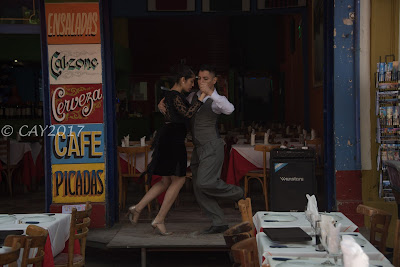We walked the afternoon away in the cobbled streets of San Telmo and wandered fortuitously into a historic literary café, La Poésia, where we had a nice dessert break. A staircase led up to a loft with a photo gallery of literary figures who had met in the café located in a turn of the 19th century building. It was a long but interesting walk back to our Recoleta hotel through the pedestrian thoroughfare Florida Street - a back to reality walk, with the street full of hawkers and solicitations. We were offered "cambio" by street money-exchangers non-stop throughout the walk down the crosstown street.
The highlight of our Buenos Aires visit was a wonderful evening at the historic Los Laureles (established 1893) tango bar, attending a "milonga" where locals danced the tango. What a fun way to end the trip!
 |
| Colourful tenements in La Boca - only the tenants would know if life is really that colourful... |
 |
| Tango and singing on the street to entice customers |
 |
| Street mural in San Telmo by famous Argentinian cartoonist Juan Carlos Colombres (Landrú) |
 |
| La Poesia, an historic literary café in San Telmo that we just happened to wander into |

 |
| Cobbled streets of San Telmo |
 |
| Pedestrian thoroughfare in Centro |
 |
| Flordia Street famous for shopping and "cambio" |
 |
| Historic milonga bar, Los Laureles, established in 1893 |
 |
| Instructor at tango lesson |
 |
| Tango demo |
 |
| Live music for locals dancing the tango at the milonga |

 |
 |
| Good night and goodbye, Buenos Aires! |
This wraps up my posts on Patagonia. It was one of the most spectacular trips we have been on. Looking forward to the next one - Munich, Salzburg and the Alps. Stay tuned!



































